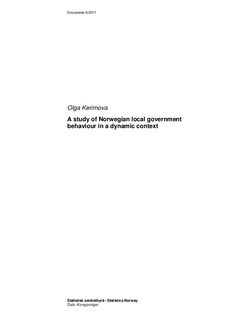A study of Norwegian local government behaviour in a dynamic context
Working paper
Permanent lenke
http://hdl.handle.net/11250/180980Utgivelsesdato
2011Metadata
Vis full innførselSamlinger
- Notater / Documents [329]
Sammendrag
Using previous work on the subject as a foundation, Norwegian local government spending behaviour is analysed in a dynamic framework facilitated by a panel dataset, combining municipality data for the years 2001 to 2008. Local governments are assumed to be utility maximising agents and therefore choose the best combination of budget surplus or deficit and output of public services, subject to the budget constraint that total spending does not exceed total income, which consists of grants from the central government and local taxes. The analysis is conducted in a simultaneous framework using a structural Linear Expenditure System model where government expenditure in each service sector is endogenous and dependent on the expenditures in the other sectors. Extending existing research on the subject, this study analyses changes over time in local government spending behaviour, exploiting both cross-section and time-series variation in the data to account for any unobserved municipality or time heterogeneity. Panel data methods such as fixed effects are found to be well suited to the analysis with unobserved time and municipality heterogeneity playing an important role in the changes in spending patterns. Moreover, the observed sluggishness of spending adjustment over time suggests that a combination of fixed and/or time effects with a dynamic partial adjustment model is a promising specification for future research
